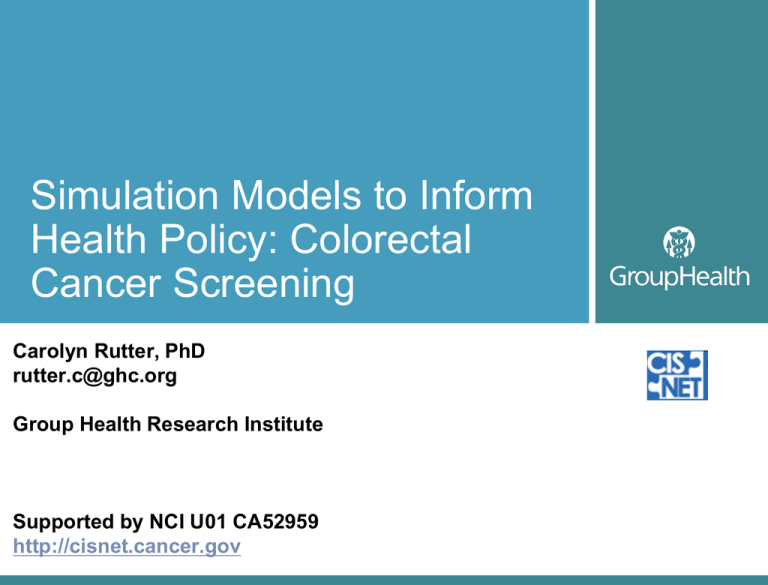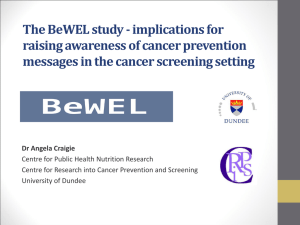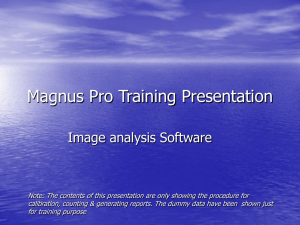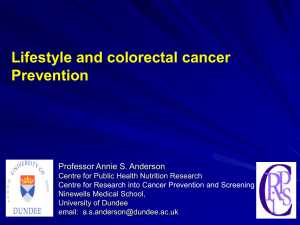
Simulation Models to Inform
Health Policy: Colorectal
Cancer Screening
Carolyn Rutter, PhD
rutter.c@ghc.org
Group Health Research Institute
Supported by NCI U01 CA52959
http://cisnet.cancer.gov
Models for Mammography
On Nov 16, 2009 the United States Preventive Services Task Force
(USPSTF) revised its recommendations for screening mammography,
indicating that most women should start regular breast cancer
screening at age 50, not 40, and women should test every other year
instead of every year.
The change was made in light of:
New data, including a very large study of mammography initiated at
40 from England (~1.5 million)
New focus on harms, including work-up following a false positive
test and over diagnosis and treatment of cancer that would not
otherwise have been detected in a woman’s lifetime.
Results from disease models (CISNET)
The models did not provide consistent results about over-diagnosis,
with estimates that ranged from 6% to 50% of breast cancers.
However, there was agreement that mammograms every two years
give the nearly the same benefit as annual ones but confer half the
risk of harms, and that there was little benefit to screening women in
their 40’s.
(Paraphrasing Don Berry)
April, 2011
New York Times, 11/22/09: “Behind Cancer Guidelines, Quest for Data”, Gina Kolata
2
Models for Colorectal Cancer
November 2008: The USPSTF used microsimulation models to guide
recommendations for colorectal cancer screening.
Both models supported a range of screening strategies, starting
at age 50 up to age 75:
• colonoscopy every 10 years
• annual FOBT
• flexible sigmoidoscopy every 5 years with a mid-interval FOBT
Zauber, Lansdorp-Vogelaar, Knudsen, et al 2008
January 2009: The Medicare Evidence & Discovery Coverage Advisory
Committee considered coverage of CT colonography for colorectal
cancer screening, based on:
• Operating characteristics & risks of different tests (systematic review)
• Expert Testimony
• Model Predictions
Knudsen, Lansdorp-Vogelaar, Rutter, et al 2010
Recommendation: Insufficient evidence to support CTC for screening
www.cms.hhs.gov/mcd/index_list.asp?list_type=mcac
April, 2011
3
Microsimulation Models
Microsimulation models simulate outcomes in a population of
interest by simulating individual event history trajectories.
A natural history model refers to the mathematical formulae
that describe these individual histories.
The natural history model is combined with a screening or
treatment model to project population-level effects of treatment.
Existing models describe:
• Cancers: prostate, breast, lung, colorectal, esophogeal,
cervical
• Cardiovascular disease, diabetes
April, 2011
4
Adenoma to Carcinoma Pathway
Normal
Epithelium
Small
Adenoma
Advanced
Adenoma
Colorectal
Cancer
Thanks to Ann Ann Zauber!
April, 2011
5
Example: CRC-SPIN model for colorectal cancer
ColoRectal Cancer Simulated Population model for Incidence and Natural history
no
lesion
t1
adenoma
Time-Dependent
Poisson Process
with intensity i(t)
i(t) a function of
•age
•gender
•patient-specific risk
t2
invasive
disease
adenoma growth model
+
P(invasive) = (size)
t3
clinical
disease
DEATH
Lognormal sojourn
time model)
Rutter & Savarino, Cancer Epidemiology Biomarkers & Prevention, 2010
April, 2011
6
CRC-SPIN model for colorectal cancer
Model Summary
1. Adenoma Risk Model (7 parameters):
2. Adenoma Growth Model: Time to 10mm (4 parameters)
3. Adenoma Transition Model (8 parameters)
4. Sojourn Time Model (4 parameters)
April, 2011
23 parameters
7
CRC-SPIN model for colorectal cancer
Adenoma Location: Multinomial distribution,
informed by 9 autopsy studies (and similar to a
recent colonoscopy study) :
P(cecum)
P(ascending colon)
P(transverse colon)
P(descending colon)
P(sigmoid colon)
P(rectum)
=
=
=
=
=
=
0.08
0.23
0.24
0.12
0.24
0.09
CRC Survival:
Assign CRC survival using survival curves estimated SEER survival data
from 1975 to 1979, stratified by location (colon or rectum) and AJCC stage
with age and sex included as covariates.
Other Cause Survival:
Assign other-cause mortality using product-limit estimates for age and
birth-year cohorts from the National Center for Health Statistics Databases.
April, 2011
0 parameters
8
Calibrating Models in Economic
Evaluation: A Seven-Step Approach
Vanni, Karnon, Madan, et al. Pharmacoepidemiology, 2011
1. Which parameters should be varied in the calibration
process?
2. Which calibration targets should be used?
3. What measure of goodness of fit (GOF) should be used?
4. What parameter search strategy should be used?
5. What determines acceptable GOF parameter sets
(convergence criteria)?
6. What determines the termination of the calibration process
(stopping rule)?
7. How should the model calibration results and economic
parameters be integrated?
April, 2011
9
Example:
Calibration of CRC-SPIN
23 Parameters
no
lesion
1 study of
Adenoma
Prevalence
(3 age groups)
29 data
points
April, 2011
t1
adenoma
2 studies of
crosssectional
size
information
(3 size
categories)
t2
invasive
disease
1 study of preclinical
cancer incidence
t3
clinical
disease
SEER cancer
incidence rates
by age, sex, &
location (1978)
+ Expert opinion about t1, t2, and t3 and
10
prior information, about adenoma prevalence
Microsimulation Model Calibration:
Published Approaches
• One-at-a-time parameter perturbation, with subjective judgment
• One-at-a-time parameter perturbation, with chi-square or deviance statistics
• Grid Search using objective functions (e.g., likelihood)
• Undirected: evaluate objective function at each node or at a random set of
parameter values.
Not computationally feasible for highly parameterized models,
dense grids can miss maxima.
• Directed: move through the parameter space toward improved goodness of fit to
calibration data.
Fewer evaluations of the likelihood, but can converge to local maxima.
A key challenge is numeric approximation of derivatives.
• Likelihood approaches
• Bayesian estimation (MCMC, other approaches are possible)
• Simplify the likelihood to allow usual estimation approaches.
The simplified model needs to be flexibly enough to be useful for prediction
• Active area of research
April, 2011
11
Microsimulation Model Calibration
Bayesian calibration approach:
• Place priors on model parameters (allows explicit incorporation of
expert opinion)
• Use simulation-based estimation (Markov Chain Monte Carlo or
Sampling Importance Resampling)
April, 2011
12
Microsimulation Model Calibration
Bayesian model:
data distribution: Y | (y;)
prior distribution: ~ (·)
posterior distribution
| y ~ h(;y) = (y;) (·)/ (y)
Bayesian Estimation:
• Closed form posterior
• Simulation-based estimation:
* Markov Chain Monte Carlo (MCMC)
* Importance sampling
Microsimulation model:
data distribution: Y | (y;g())
prior distribution: ~ (·)
posterior distribution
| y ~ h(;y) = (y;g()) (·)/ (y)
Likelihood is not closed form
The data distribution is
parameterized by g(), an unknown
function of model parameters.
Data sets do not have a 1-1
correspondence with model
parameters.
Solution: Simulate data given θ,
and use this to simulate g(θ)
JSM Vancouver, 2010
13
Microsimulation Model Calibration
Advantages of Bayesian Calibration (simulated draws from
the posterior distribution):
• Interval estimation
• Posterior predicted values for calibration data (Goodness of Fit)
• Can compare prior and posterior distributions to gain insight about
parameter identifiability (Garrett & Zeger, Biometrics 2000)
April, 2011
14
Bayesian MSM Calibration
Overlap Statistic
Compare prior and posterior distributions
Garret & Zeger `Latent Class Model Diagnostics', Biometrics, 2000
De n s i t y
1. 3
De n s i t y
130
1. 2
120
1. 1
110
0.79
1. 0
0.51
100
0. 9
90
0. 8
80
0. 7
70
0. 6
60
50
0. 5
40
0. 4
30
0. 3
20
0. 2
10
0. 1
0
0. 0
0. 00
- 9
- 8
- 7
- 6
0. 01
0. 02
0. 03
0. 04
0. 05
0. 06
0. 07
0. 08
- 5
Va l u e
Va l u e
Va r i a b l e
Va r i a b l e
JSM Vancouver, 2010
p r i o r r i s k me a n
pr i or r i skage80
r i skage80m
r i s k me a n
15
Microsimulation Model Calibration
A 2009 review by Stout and colleagues (Pharmacoeconomics) found:
• Most modeling analyses did not describe calibration approaches
• Those that did generally used either undirected or directed grid
searches.
Big problem: lack of information about precision.
Grid searches generally provide point estimates, with no measures of
uncertainty for either estimated parameters or resulting model
predictions.
A few ad hoc approaches have been proposed, for example:
• ‘uncertainty intervals’ based on sampling parameters over a
specified range
• Provide a range of predictions based on parameters that provide
equally good fit to observed data.
April, 2011
16
Example of a Modeling Analysis
Table 8C. Undiscounted costs by type, number of life-years gained, and number of
cases of CRC per 1000 65-year-olds, by screening scenario – SIMCRC
Screening
Costs
0
Total
Costs
$3.5M
SENSA
$122K
$2.8M
151
8
18
FIT
$248K
$2.6M
148
8
19
FSIG+SENSA
$444K
$2.7M
170
5
13
FSIG+FIT
$638K
$2.8M
170
5
14
CSPY
$783K
$2.7M
171
6
11
CTC(1)
$1.1M
$3.3M
168
6
12
CTC(2)
$1.2M
$3.3M
160
7
12
Scenario
No Screening
April, 2011
LYG
0
Symptomatic Screen-Det
CRC
CRC
60
0
17
April, 2011
18
Simpler models, similar answers
Comparative Effectiveness Studies of CT colonography
(Rutter, Knudsen, Pandharipande, Aca Radiol, 2011)
Literature review:
1 decision tree model
6 cohort models
3 microsimulation models
Similar overall disease processes (adenoma-carcinoma), similar
‘calibration’ data, but different levels of detail.
Microsimulation models: multiple adenomas, of different
sizes and in different (& detailed) locations in the colorectum
Cohort / decision tree models: most with one adenoma,
one with two in either the proximal or distal colon.
April, 2011
19
Simpler models, similar answers
First
Author
Year
Model Type
Most
Least
Effective Costly
Most
Cost-Effective
Heitman
2005
Decision Tree
CSPY
CSPY
CSPY
Sonnenberg
1999
Cohort
CSPY
CTC
CSPY
Ladabaum
2004
Cohort
CSPY
CSPY
CSPY
Vijan
2007
Cohort
CSPY
CSPY
CSPY
Hassan
2007
Cohort
CSPY
CTC
CTC
Lee
2010
Cohort
CSPY
CTC
CTC & CSPY
Telford
2010
Cohort
CSPY
CSPY
CSPY
Knudsen
2010
Microsim
CSPY
CSPY
CSPY
April, 2011
20
Costs: CTC vs colonoscopy with
and without polypectomy
colonoscopy
Lee et al
Hassan et al
April, 2011
CT
21
Accuracy of CTC v Colonoscopy
Assumptions made by Lee et
Assumptions made by Hassan et al
al
Small lesions not modelled
April, 2011
22
What next?
Simulation models are increasingly being used to inform
health policy
Useful tool, with some shortcomings
o Many are complex (when do simper models make sense?)
o Few methods for estimating the precision of model
predictions
o Few (no?) models are ‘public use’
Potential for other applications
o Study design
April, 2011
23






